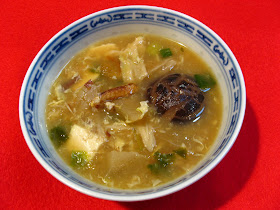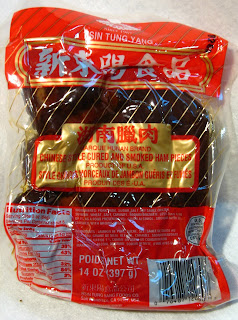I made this tasty soup for my family’s 2016 Thanksgiving
dinner, and is very similar to the soup I made for Christmas 2015: Seafood
Winter Melon Soup (海鮮冬瓜羹, Hoi2 Sin1
Dung1 Gwaa1 Gang1). The soup is loaded
with lots of seafood and is a special occasion type dish. I was able to get sliced
abalone at my local Asian market. Usually fresh (or thawed) abalone is very
hard to find where I live (it’s usually only available frozen or dried), so I
took the opportunity to use it in this soup. Since abalone becomes tough if
cooked too long, the abalone is added as the very last ingredient to the soup
just to warm it in order to keep it tender.
Fish maw is the bladder of the fish that controls buoyancy.
Fish maw is one of those weird and wonderful special banquet ingredients (at
least in my experience) that is served at auspicious events such as weddings
and at Lunar New Year. Fish maw can be purchased at your local Asian market or
herb specialty store. If you’re lucky enough to have an Asian herb store near
you, it’s worth going in to see all the dried herbs and creatures that are sold
at these stores. The herb stores also have the most variety of fish maw to buy
and with the prices to match!
There are two types of fish maw: dried and fried. For this
soup dish, the fried version is used. If you purchase the dried version, like I
did, there’s an extra step to deep fry the fish maw yourself. I actually
shallow fried the fish maw, ladling hot oil over the fish maw (be careful when
using this method). You can save a step and time by buying the fried version.
The best description of fried fish maw is that it look like chicharrón, which
is fried pork skin. The fried fish maw has to soak in cold water for at least
an hour to soften it to a spongy texture and then cut into bite sized pieces.
After soaking, fish maw has no inherent flavor (so it won’t smell fishy at all)
and acquires the flavors of the ingredients it is cooked with. So the use of a
good stock and ingredients is important to the flavor of this soup.
The soup stock was made using the Bone Soup
(湯, Tong1) recipe. You can
used a prepared soup stock, but the taste of the soup is heavily dependent upon
the quality of the ingredients. So if you’re going to all the trouble and
expense to make this soup, you should make your own soup stock. The last
Chinese character in the recipe’s name, 羹 (gang1), signifies that this is a thick soup. A
thick soup means that a corn starch solution is added to thicken the soup. The
amount of thickener added to the soup depends upon personal preference, but the
soup should be thicker than a normal soup and not thicker than a very thick
gravy.
Enjoy!
Ingredients
|
3 oz.
|
85 g.
|
Fish maw (魚肚, jyu4
tou5), fried and rehydrated
|
|
1 oz.
|
30 g.
|
Dried scallops (瑤柱,
jiu4 cyu5), rehydrated and separated into pieces
|
|
1 lb.
|
500 g.
|
Crab meat (蟹肉, haai5 juk6) – meat from about two Dungeness
crabs
|
|
1 lb.
|
500 g.
|
Sliced abalone
(鮑魚, baau1 jyu4)
|
|
|
|
|
|
24
|
24
|
Dried whole Shiitake
mushrooms (冬菇, dung1
gu1), rehydrated
|
|
6 oz.
|
170 g.
|
Hsin Tung Yang brand Chinese Style Cured and Smoked Ham
(湖南臘肉, wu4 naam4
laap6 juk6) or equivalent, cut into thin pieces
|
|
16 oz.
|
454 g.
|
One package soft tofu (豆腐, dau6 fu6), cut into ½-inch (15
mm.) cubes
|
|
1 in.
|
30 mm.
|
Knob of ginger
(薑, goeng1), cleaned and sliced
into thin pieces
|
|
2 lb.
|
1 kg.
|
Winter melon (冬瓜, haai5 juk6), skin removed and cut into
1-inch (2.5 cm.) cubes
|
|
3 stalks
|
3 stalks
|
Green onions (葱, cung1), cut into ½-inch (15 km.) pieces
|
|
½ bunch
|
½ bunch
|
Cilantro (芫茜, jyun4 sai1), cut into ½-inch (15 km.) pieces
|
|
2
|
2
|
Eggs (雞蛋, gai1 daan6), scrambled
|
|
|
|
|
|
2 Tbs.
|
30 ml.
|
Soy sauce (豉油, si6 jau4)
|
|
2 Tbs.
|
30 ml.
|
Shaoxing rice
wine (紹興酒, siu6 hing1 zau2)
or dry sherry
|
|
½ tsp.
|
2.5 ml.
|
Ground white
pepper (白胡椒, baak6 wu4 ziu1)
|
|
|
|
|
|
3 Tbs.
|
45 ml.
|
Corn starch (粟粉, suk1 fan2)
|
|
6 Tbs.
|
90 ml.
|
Water
|
|
|
|
|
|
4 qt.
|
4 L.
|
Bone soup
(recipe can be found here)
|
|
|
|
|
|
|
|
Sesame oil (麻油, maa4 jau4) added to serving bowls, to taste
|
Equipment
|
8 qt.
|
7.5 L.
|
Pot
|
|
14 in.
|
35.5 cm.
|
Wok or pan
|
This recipe easily makes twelve bowls of soup and can be
adjusted to make soup for fewer people.
 |
| Unfried Fish Maw (魚肚, jyu4 tou5) |
Instructions (One Day Before)
 |
| Fried Fish Maw (魚肚, jyu4 tou5) |
- The stock for this soup is based on the Bone Soup (湯, Tong1) recipe, which should be prepared at least one day ahead.
- There are two types of fish maw: dried and fried. The type needed for the soup is the fried version. If the dried version was purchased, the fish maw should be first deep fried in a neutral oil at 350⁰ (175⁰C) until the fish maw puffs up. You can also shallow fry the fish maw by frequently ladling the hot oil over the fish maw (be careful when using this method) in a wok. If possible, purchase the fried version and save a step in making this dish. The fried fish maw can be stored in a covered container at room temperature.
- Pour boiling water over the dried scallops in a heat proof
bowl and rehydrate the scallops overnight. Remove the scallops from the
rehydration liquid, and break into small pieces. Reserve the rehydration liquid for later use in the cooking process. If you need to rehydrate the scallops quickly, use the method to rehydrate Shiitake mushrooms quickly (it works for dried scallops): Technique: How to Quickly Rehydrate Dried Shiitake Mushrooms (冬菇, Dung1 Gu1).Hsin Tung Yang Brand
Chinese Style Cured and Smoked Ham
(湖南臘肉, wu4 naam4 laap6 juk6) - If using fresh cooked crab, separate the meat from the shells and store in a covered container in the refrigerator. If using frozen crab meat, thaw the crab in the refrigerator overnight.
- If using frozen abalone slices, thaw the abalone in the refrigerator overnight.
Instructions (Cooking Day)
- Pour boiling water over the dried Shiitake mushrooms in a heat proof bowl and rehydrate the mushrooms for at least one hour. Remove the Shiitake mushrooms from the rehydration liquid, and remove the stems. If you need to rehydrate the Shiitake mushrooms quickly, use the method described here: Technique: How to Quickly Rehydrate Dried Shiitake Mushrooms (冬菇, Dung1 Gu1).
- Take the abalone and crab meat out of the refrigerator at least one hour before cooking.
- Cut the Hsin Tung Yang brand Chinese Style Cured and Smoked Ham, or equivalent, into small pieces.
- Open the package of soft tofu and drain the liquid. Cut the soft tofu into ½-inch (15 mm.) cubes.
- Remove the tough outer skin of the ginger and slice into thin pieces. Scraping the ginger’s skin with a spoon is a fast and easy way to remove the skin without wasting much of the ginger.
- Remove the seeds and skin from the winter melon. Use a spoon or your hands to remove the seeds, and a sharp knife to remove the skin. Cut the winter melon into 1-inch (2.5 cm.) cubes. Two pounds (1 kg.) of winter melon with seeds and skin will yield about 1.5 lb. (750 g.) of winter melon meat.
- Wash and cut the green onions and cilantro into ½-inch (15 mm.) pieces.
- Scramble the eggs in a small bowl.
- Mix the corn starch and water together in a small bowl.
- Put the bone soup stock, ginger slices, scallops, scallop rehydration liquid, Hsin Tung Yang brand Chinese Style Cured and Smoked Ham or equivalent, Shiitake mushrooms, Shaoxing rice wine or dry sherry, and ground pepper into the cooking pot. Put the pot over high heat and bring the contents to a boil.
- Reduce the heat to medium-high, add the crab meat, fish maw, and soft tofu to the soup stock, and simmer for 10-15 minutes. The soup should almost or just be boiling before adding the winter melon to the soup and cooking for 2-3 minutes.
- Taste the soup and adjust the flavor, adding small amounts of soy sauce at a time. The soy sauce can be omitted if desired.
- The soup should not be boiling when the corn starch solution is added, otherwise the soup will become lumpy. However, in order to thicken the soup, the soup must be brought to a boil. So the heat must first be reduced until the soup stops boiling, then the corn starch solution added slowly while stirring constantly, and then the heat increased while stirring until the soup boils. Once the soup boils, the thickness can be determined. If the consistency is not adequate, then the procedure must be repeated until the desired thickness is achieved. The thickness of the soup is a personal preference, and should be somewhere between the thickness of normal soup and that of a thin gravy.
- The soup should be boiling before adding the scrambled eggs slowly to the soup, stirring constantly. The scrambled eggs should break into strands if added slowly to the boiling soup while stirring. If you add the eggs too fast or don’t stir constantly, you’ll get clumps of egg – while still edible, the presentation is not as nice.
- Add the abalone slices, green onions, and cilantro to the soup and stir. The abalone only needs to be warmed, since if cooked too long, the abalone will become tough.
- Turn off the heat and transfer the soup to serving bowls. Some sesame oil can be added to the serving bowls before serving if desired.


No comments:
Post a Comment